![]() 1st Battalion 22nd Infantry
1st Battalion 22nd Infantry ![]()
Crisbecq, Azeville and Quineville
June 8 - 14, 1944
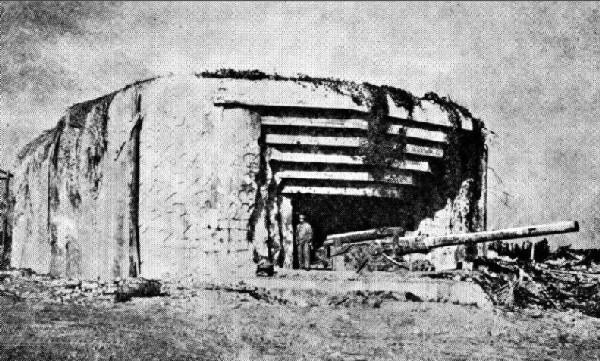
One of the 210mm guns at Crisbecq, after its capture.
Progress had been especially difficult in the 22d Infantry sector. There, along the beach and at the headland fortifications, the enemy offered stubborn resistance. After the costly failure of the attacks on Crisbecq and Azeville on 7 June, the regimental commander, Col. Hervey A. Tribolet, waited for the 3d Battalion (minus Company K) to assemble west of the inundated area near Ravenoville as a reserve force, before he renewed the push northward. During the night, however, the 3d Battalion moved across the inundation to accept the surrender of Taret de Ravenoville. Company K, reinforced by 4.2-inch mortars, antitank guns, heavy machine guns, and part of a NSFCP, continued to attack the beach fortifications farther to the south.
At 1000 on 8 June the 1st and 2d Battalions again attacked Azeville and Crisbecq (Map VIII). On the right the 1st Battalion drove the enemy out of St. Marcouf, which he had reoccupied during the night, and advanced on Crisbecq. As on 7 June, Companies A and B led the attack, with Company C organized for assault and prepared to pass through the center. At 1330 a 20-minute preparation of naval and field artillery and mortar fire began to pound Crisbecq; it gave way to a rolling barrage which the infantry followed at 200 yards. Company D provided overhead fire with heavy machine guns. The advance and the fires were effectively coordinated, permitting the battalion to reach the edge of the fortifications with few losses. Companies A and B took positions on the flanks while Company C advanced through the center and blew several emplacements with pole charges.
The battle then developed in the same way as it had on the previous day. The assault sections exhausted their explosives without destroying the main enemy fortifications and became engaged in close-in fighting with the Germans in the trenches. The whole battalion was shelled by Nebelwerfers and by the guns at Crisbecq and farther inland, and its left flank was again counterattacked. As the pressure mounted on the left, the battalion fell back under cover of smoke, as it had on the previous day, to the orchard north of Bas Village de Dodainville. On first check the battalion showed less than half strength, but during the night a large number of men, separated in the course of the fighting, found their way back to the line which the battalion had organized. At Azeville, the 2d Battalion had also repeated its experience of 7 June when it had been driven back by a counterattack.
On 9 June the Azeville mission was assigned to the 3d Battalion (less Company K), which had again moved inland from Taret de Rave-noville. The plan to take Crisbecq was temporarily abandoned, although naval and artillery fire continued to neutralize its batteries. The fort at Azeville, roughly circular, encompassed the east edge of the village. It consisted of four large concrete blockhouses camouflaged as buildings, which were armed with 105-mm. guns and turreted machine guns, and interconnected by covered trenches. The southern approach was protected by small outlying pillboxes and mine fields, and the entire area was surrounded by varying widths of barbed wire entanglements. The roads in the vicinity were blocked.
The 3d Battalion assembled about 1,000 yards southeast of Azeville, and at 1100 it crossed to the draw southwest of the village. Company L moved farther west in a wide arc in order to enter the village from the west and capture any reserves the enemy might have to the rear of the fort. Company I organized into five assault sections, moved north inside the arc of Company L, and advanced up the draw and through the fields to approach the fort from its right rear. The 44th Field Artillery Battalion fired 1,500 rounds in preparation for the attack. The company started out with the support of tanks, but mines held up all except one of them. At noon Company I came in sight of the first outlying pillbox. The men did not attempt to lift the mines, but after cutting the wire they picked their way through the fields and orchards. They buttoned up pillboxes with rifle fire and then blew them. Enemy return fire was not heavy. The Germans had neglected to clear good fields of fire and to cover the approach from the southwest. Company I concentrated on the nearest blockhouse. First bazookas and the lone tank opened fire from behind a hedgerow, but accomplished little more than to chip the concrete. An assault team was then sent in to blow the rear entrance, which was recessed in the blockhouse and out of reach of direct fire. The team worked its way to its objective, emptied its flame thrower, and set off a pack charge. But this had no effect, nor did a second attempt, nor a third with a still heavier satchel charge. In a last effort Capt. Joseph T. Samuels, commanding Company I, sent Pvt. Ralph G. Riley to the blockhouse with the last flame thrower to "give it a few more squirts." With the flame thrower on his back, Private Riley ran seventy-five yards under fire and dropped into a shell hole for cover. The flame thrower would not work, and he tried to think of the proper "immediate action." He opened the valve, held a lighted match to the nozzle, and trained the stream of fire on the base of the door. At just this time enemy artillery fire from Crisbecq began to come in and Captain Samuels thought the attack had failed. Suddenly Private Riley heard a popping sound, different from the sound of the rifle fire around him. It was soon followed by explosions within the blockhouse. The enemy's ammunition had been fired by those "few more squirts" of the flame thrower. Soon a white flag was raised and, after the firing had ceased, the rear door of the blockhouse swung open to let out an American parachute officer followed by two Germans. The German commander surrendered all 4 forts with their garrison of 169 men.
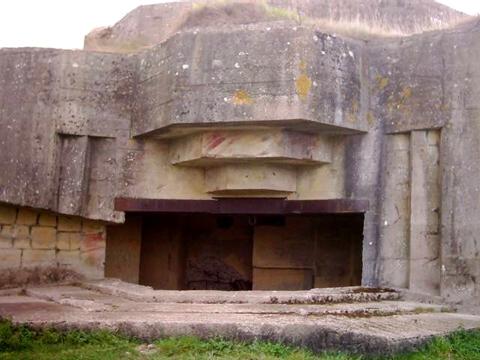
One of the gun emplacements at Azeville, as it looks today
Ozeville
Shortly after Azeville was captured in mid-afternoon, 9 June, General Barton issued an order creating a task force which that same day was to bypass Crisbecq and the other German strong points along the coastal headlands and swing northeast to "capture Quineville and the high ground west thereof." Quineville was the eastern anchor of the German defenses. The task force, which was to have first priority on division fires, consisted of the 22d Infantry, the 899th Tank Destroyer Battalions and the 746th Tank Battalion (less detachments); it was commanded by Brig. Gen. Henry A. Barber. Led by tanks, the 22d Infantry was to advance in a column of battalions (3d, 2d, 1st) on Ozeville, its first objective. Crisbecq was to be contained by a force of tank destroyers and infantry and was to be neutralized by division artillery at the time of the attack. The containing force, commanded by Maj. Huston M. Betty, consisted of Company C, 22d Infantry; Company C, 4th Engineer Combat Battalion; Company C, 899th Tank Destroyer Battalion.
The task force moved out at 1630, but it was stopped by fire from strong enemy positions at the crossroads west of Chateau de Fontenay and forced to dig in for the night. For three days (10-12 June) the task force struggled with little success to overcome the enemy resistance, its right flank exposed to the bypassed enemy strong points at Crisbecq, Dangueville, Chateau de Fontenay, and Fontenay-sur-Mer and its left flank to the German positions in the gap of about a mile and a half that separated the 22d and 12th Infantry Regiments. The task force lacked sufficient strength to protect both of its flanks and at the same time push ahead. Unfavorable weather denied it air support.
On 10 June the 3d Battalion, supported by tanks, launched two frontal attacks on Ozeville which carried it up the rising ground to within a few hundred yards of the enemy entrenchments. But the battalion, consisting of only two companies, was too weak to gain the objective. Company K was still on the beach and Company L had lost 159 men since D Day. On the same day the 2d Battalion attacked on the right in an effort to reduce the strong point at Chateau de Fontenay, but it was pinned down by grazing machine-gun fire. Ordered to withdraw to allow bombing of the enemy positions, the battalion became disorganized by the enemy fire, and seventy men east of the chateau were left stranded. Only one of these men returned-an aid man who was later found among the prisoners at Cherbourg. The air mission did not materialize.
On 11 June, General Barber planned to send the 1st and 3d Battalions into Ozeville from the west, after an air mission had softened the enemy positions. But he was forced to divert the 1st Battalion to the right to contain the enemy positions at Fontenay-sur-Mer and Dangueville. The 3d Battalion therefore attacked Ozeville alone, but again failed.
While the 2d and 3d Battalions suffered heavy losses in unsuccessful attacks on the chateau and the Ozeville strong point, the 1st Battalion contained the enemy at Fontenay-sur-Mer and another force contained the Crisbecq fortification. Twice on 10 June this latter force pulled back for scheduled air missions which were canceled because of unfavorable weather. The only real progress during these days was made on the beach by Company K, which on 11 June captured two more strong points. For two days it had hammered at these positions. At last it learned from prisoners that the only effect of heavy American fire on the forts had been to force the garrison to shuttle through a tunnel from one part to the other. Company K therefore fired fifty rounds of 57-mm. on the first fort and then switched suddenly to put eighty rounds into the adjacent stronghold. Resistance ended in both forts, and ninety-three prisoners were taken.
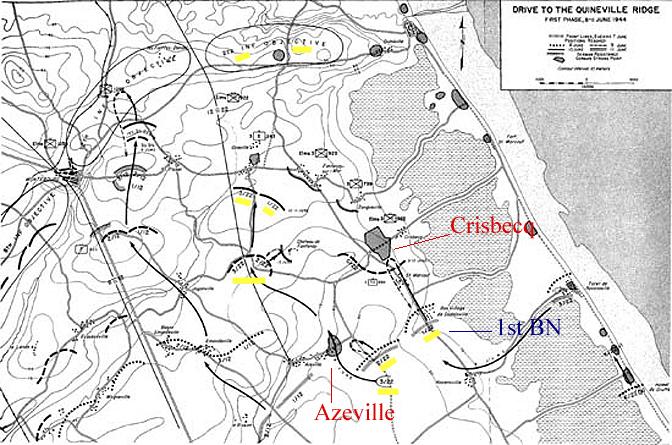
Map VIII
On 12 June, General Collins ordered the 39th Infantry, 9th Division, which had landed on the previous day, to take over the reduction of the enemy strong points on the beaches and the coastal headlands. General Collins had two reasons for this move. He was determined to reduce the beach and headland fortifications from Taret de Ravenoville to Quineville, for they continued to shell Red Beach and threatened to slow down the unloading of supplies; and he wished to free the right flank of the 22d Infantry, in order that it might move on to Quineville. With this in view, the 1st Battalion of the 22d Infantry was released from its task of containing Fontenay-sur-Mer and Dangueville and ordered to rejoin the regiment for the drive northward.
Early on 12 June the 39th Infantry fanned out from its assembly area on its coastal missions (Map IX). The 2d Battalion pushed patrols to Crisbecq and, finding it abandoned, occupied it at 0820. Dangueville was occupied in mid-afternoon. Two companies were then sent eastward toward the beach. The 1st Battalion moved to St. Marcouf at noon and then sent three companies down the roads from St. Marcouf and Ravenoville to the beach. There the battalion reorganized and assaulted and captured the first pillbox north of Taret de Ravenoville, establishing contact with the 2d Battalion patrol below Fort St. Marcouf. The 3d Battalion meanwhile attacked through the 1st Battalion, 22d Infantry, drove the enemy back from Fontenay-sur-Mer, where he resisted stubbornly, and established outposts along the roads to the north and east.
The 22d Infantry was now free to make a concerted attack on Ozeville. It was to jump of at noon of 12 June. The air force was to bomb Ozeville at 1100, and the artillery (44th and 20th Field Artillery Battalions) was to fire on known enemy positions south of Ozeville from 1115 to 1130, then lift to Ozeville until 1200, after which fire was to be available on call. In addition to the organic weapons of the 22d Infantry, the attack was to be supported by two platoons of 81-mm. mortars and the Cannon Company of the 12th Infantry. The 2d Battalion, 22d Infantry, on the left flank was to place mortar and antitank fire on the strong point from 1115 until 1200; and the 1st Battalion on the right flank was to support the attack with its tanks and cannon. Colonel Teague's 3d Battalion in the center, which was to lead the attack, was to be supported by one company of chemical mortars (87th Chemical Mortar Battalion), a platoon of tanks (Company C, 70th Tank Battalion), and an extra platoon of antitank guns.
At 1005 General Barber notified Colonel Teague that the air mission was canceled, but that heavy artillery fire would be substituted. The preparatory fires were delivered and the attack jumped off on time. With the 2d Battalion covering the gap on the left flank and the 1st Battalion becoming heavily engaged in the vicinity of Fontenay-sur-Mer, the main assault was made by the 3d Battalion alone toward the southwest corner of the strong point.
The troops advanced behind overwhelming fire power. Even naval support was available, particularly on Quineville where German guns had opened up. Covered by Companies I and L on either side, two assault sections of Company K closed in on the Ozeville defenses. After a short but violent fight a white flag appeared on one of the positions. But as Lieutenant Dewhurst, a platoon leader, climbed up on a pillbox to stop the firing, he was cut down by German fire. The men of Company I suddenly fought with greater fury; they rushed into the emplacements with bayonets and grenades and wiped out a large part of the garrison.
Ozeville was captured and the last major barrier to an attack on Quineville was removed. On the same day, 12 June, the 39th Infantry cleared resistance from the 22d Infantry's right flank, while on its left flank the 12th Infantry retook the ground east of Montebourg which had been relinquished the day before.
The 12th Infantry's attack was launched at 1600, when the capture of Ozeville became assured. After an artillery preparation the 2d Battalion moved against its objective, the strong point built around two stone quarries near les Fieffes-Dancel (Map IX) . While tanks gave close fire support, Company E assaulted the position with rifles and hand grenades. An enemy counterattack from the northwest, threatening to check the assault, was thrown back, mainly by Company B which had been sent up from the 1st Battalion in reserve to reinforce the 2d Battalion. The 2d Battalion then completed the capture of the stone quarry position. The 3d Battalion on the left had, in the meantime, captured the height 1,000 yards to the west, and Company A had established an outpost northeast of Montebourg. The 12th Infantry was again extended in an exposed position.
So far no attempt had been made to seize the city of Montebourg. When the two regiments approached the city on 10 June, General Barton ordered them to stay out of it; his division was spread out over a wide front with few reserves and, expecting a counterattack, he wished to avoid street fighting. On 11 June the 4th Engineer Combat Battalion established road blocks on the highway south of Montebourg and covered the gap between the 8th and 12th Infantry Regiments. But on 12 June patrols reported that the town was only lightly held. At the same time the 4th Division's burden had been lightened by the attachment of the 39th Infantry, and by the arrival of the rest of the 9th Division as Corps reserve. General Barton therefore notified Colonel Van Fleet that Montebourg was included in the 8th Infantry's zone and should be seized and occupied that day if it could be done cheaply.
Colonel Van Fleet organized a battalion-size task force to attack Montebourg and placed it under the command of Lt. Col. Fred Steiner, his executive officer. The task force, composed of two rifle companies, a platoon each of engineers, heavy machine guns, anti-tank guns, 4.2-inch mortars and tank destroyers, a cannon company, and the 29th Field Artillery Battalion in direct support, moved out at 2100 and reached the edge of the town at dark. Although the German force inside the town was not believed to be large, approaches were well covered by automatic fire. One company, on the left, was forced to withdraw and reorganize, and Colonel Steiner decided to wait until morning to renew the attack. At 0700 on 13 June the task force moved out again, one company on either side of the highway. Upon reaching the stream on the very edge of the town, the tank destroyers decided not to venture farther because of the 88-mm. fire. General Barton then resolved against risking the loss of men in street fighting and ordered the force to take a position from which it could contain Montebourg. Small patrols were sent into the town to observe enemy activity.
|
The grave marker for Sergeant Everett C. Carlson, Company K 22nd Infantry, Killed In Action June 12, 1944, D-Day cemetery, Normandy, France Photo by Terry Kotschwar, Company A 1/22 Infantry 1975-1979 |
The Capture of Quineville
Enemy possession of Montebourg technically exposed the left flank of the 22d Infantry's attack toward Quineville. But the danger was not too great and General Barton hoped to gain Quineville and the ridge to the west on 13 June. However, neither the 39th Infantry nor the 22d Infantry was able to make sufficient progress. The 1st Battalion of the 39th attacked northward along the beach toward Fort St. Marcouf, aided by 2d Battalion mortars and four tank destroyers, but it made only small gains (Map IX). The 3d Battalion attacked east from Fontenay-sur-Mer to the edge of the swamp and then north, with the intention of clearing the balance of the regimental zone south of the Quineville-Montebourg highway and along the north edge of the inundation. But it was held up by both friendly and enemy artillery fire falling on its forward elements.
The 22d Infantry reached the ridge but was unable to secure it or attack eastward to Quineville. The 2d Battalion made a wide swing through the 12th Infantry's area to the Montebourg-Quineville highway east of les Fieffes-Dancel. The 3d Battalion moved north to the forward slope of the ridge and then was ordered to side-slip to the east in preparation for an attack in column down the ridge on Quineville. Colonel Teague extended one company to the right, passed the second across its rear farther to the right, and then passed the third behind the other two. This maneuver, made across ground dominated by the enemy positions on the ridge and harassed by heavy Nebelwerfer and artillery fire, resulted in a number of casualties.
In ordering the attack of 14 June, Regiment directed all three battalions of the 22d Infantry to secure the ridge and the two hills to the east as necessary preliminaries to the attack on Quineville. The 2d Battalion, with one company of 4.2-inch mortars attached (Company C, 87th Chemical Mortar Battalion), was to seize the crest of the ridge, on the left flank. The 1st Battalion, with the 70th Tank Battalion in direct support, was to seize the eastern nose of the ridge, which was fortified, and Hill 54A to the east. The 3d Battalion, aided by a company of chemical mortars (Company A, 87th Chemical Mortar Battalion), was to capture Hill 54B, the easternmost hill, and was then to turn right and attack Quineville. Preparatory fires were to be delivered for fifteen minutes on the fortified nose of the ridge, the two heights to the east, and a coastal battery farther east. South of the highway the 3d Battalion of the 39th Infantry was also to attack and come into position for a later coordinated attack on Quineville with the 3d Battalion, 22d Infantry. The battalion was to be pinched out just south of the town.
At 0915 on 14 June the 4th Division artillery began to fire concentrations on the four ridge targets. At 0930 a round of green smoke signaled the lifting of fires and the three battalions of the 22d Infantry jumped of. The fight lasted for over three hours. By 1300 the nose of the ridge and the two hills were occupied. Meanwhile the 3d Battalion, 39th Infantry, had also taken up the attack on the southern slopes of the ridge south of the highway, completing a 90-degree turn to the east just south of Hill 4B and advancing on Quineville with Company K in the lead. The attack on the town could now proceed as planned.
Before this plan was put into effect, however, the 39th Infantry received permission from Division to send its 3d Battalion independently against Quineville without the assistance of the 22d Infantry. At 1400 thirty-six A-20 's carried out a bombardment of enemy positions at Quineville and it was desirable that this bombardment be followed as soon as possible by an infantry attack. At 1600 the 3d Battalion, 39th Infantry, moved out with Company K in the lead. Initially the company encountered little opposition and took sixty-eight prisoners. On the slopes just southwest of Quineville leading elements of the company successfully attacked a casemated 88-mm. gun and took the crew prisoner. At this time tanks of the 70th Tank Battalion, operating with the 39th Infantry, opened fire at long range on what appeared to be enemy vehicles on the right flank, and drew antitank fire. This movement on the right proved to be that of tank destroyers attached to the regiment's 1st Battalion, which was fighting its way up the beach in the vicinity of St. Marcouf. The firing ceased after identification was established by flare and radio.
As Company K entered Quineville it received heavy mortar fire, but it went on to the first street intersection. There the 3d Platoon, which had been leading the attack, turned right and advanced toward the beach. In its path lay a tank ditch, extending to the mouth of the Sinope River on the north and to the swamps on the south. As the platoon proceeded down the street a small antitank gun opened fire from a pillbox on the beach, forcing lead elements of the platoon back and driving the rest to cover in ditches and buildings.
Meanwhile the 1st Platoon had pushed into the northeast part of town with the intention of cutting through to the beach. The Weapons Platoon emplaced its 60-mm. mortars south of town and rushed up light machine guns and one section of heavy machine guns from Company M through heavy enemy fire to join the 1st Platoon. The platoon and attached guns entered the northeast section and the machine guns were set up on the edge of town, looking out onto the beach and the river mouth where the enemy had fixed positions. But the men found themselves dangerously exposed and were forced to take cover after receiving numerous casualties when they attempted to advance in the open toward the beach fortifications. The 2d Platoon succeeded in clearing the western part of town with little opposition, for the enemy's strength was concentrated on the east for the protection of the beach fortifications.
Aside from this minor success in the western part of town the attack at this point did not offer much hope of succeeding. Company I had suffered heavy casualties, including the 1st and 3d Platoon officers. The remainder of the battalion had been of little assistance. Company M's heavy mortars had been emplaced earlier to cover only the original mission of the battalion and were now out of accurate range of Quineville; they were at this point moving forward over difficult terrain and mined trails, and communications with them were out. Companies I and L had halted under the last remaining cover about 400 yards southwest of town, alerted to take up the attack on either flank of Company K, but there was little room for their deployment except in the open and across wire entanglements flanking the town.
Before resuming the attack the 3d Battalion commander, Lt. Col. William P. Stumpf, requested artillery fire on enemy fortifications. Its purpose was to cover the reorganization of Company K and the approach of tanks of the 70th Tank Battalion which were waiting outside the town, and to soften the enemy fortifications. Following this fire Company K was to assault the enemy positions under the cover of smoke, supported by the tanks. Radio communication was difficult, but the requested fire was adjusted by relay through the 39th Infantry Cannon Company and was delivered by division artillery. The fire was not effective against the concrete fortifications, but did result in a temporary cessation of enemy mortar fire. Smoke was not available at this time. One tank reached the intersection, turned east, and immediately drew fire from the antitank gun on the beach and was damaged. The tank returned the fire, but faced with the antitank ditch and heavy mortar fire, it withdrew. Two other tanks then moved up to the intersection to support the infantry, but also retired due to the heavy mortar fire.
Colonel Stumpf, observing the very limited support which the tanks were able to give and losing hope of getting the requested smoke, decided to resume the attack with the forces at hand. Company L was ordered to lead the assault on Company K's left. Company L had just moved out on the approach and was drawing mortar fire when a heavy concentration of smoke fell squarely on the enemy positions. Taking advantage of the long- awaited smoke, delivered by 4th Division artillery, Company K attacked immediately. As leading elements of the 1st and 3d Platoons reached the fortifications under the cover of the smoke, all enemy positions were suddenly surrendered, ending the fight for Quineville at 2130. Company K had lost twenty-eight wounded and five killed.
In the meantime the 1st Battalion of the 39th Infantry had continued its attack northward along the beach. During the day it suffered heavy casualties in crossing a mine field, but succeeded in taking Fort St. Marcouf. That night it made contact with patrols from the 3d Battalion. Thus, by the capture of Quineville and the ridge on 14 June, the enemy's main line in the north was broken, depriving him of his best natural defense against the advancing northern flank.
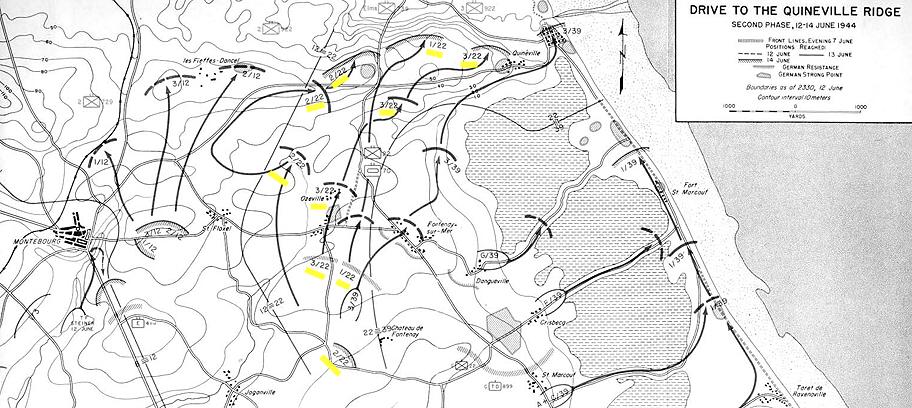
Map IX
**********************
The above is taken from:
UTAH BEACH TO CHERBOURG
by
Department of the Army Historical Division
Available online at
US Army Center of Military History
**********************
The Crisbecq battery
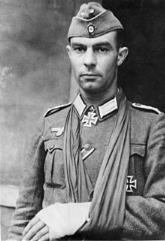
Walter Ohmsen, the
commander of the Crisbecq battery.
This photo was taken on June 14, 1944, after he received the
Knights Cross to the Iron Cross.
The battery at Crisbecq was one
of the most powerful fortifications of the German West Wall. It
was commanded by Oberleutnant zur See
(First Lieutenant) Walter Ohmsen. Ohmsen is credited as being the
first German to spot the Allied invasion fleet off the coast of
France on June 6, 1944,
and with reporting that sighting to his headquarters at
Cherbourg, thus sending the alarm about the invasion to the
German forces.
The battery consisted of two 210mm (8.25 inch)
coastal guns, one 155mm artillery piece, six 75mm anti-aircraft
guns, and three 20mm anti-aircraft guns.
In addition there were seventeen machine guns in concrete pits,
connected by a trench system, for defense against ground attack.
Surrounding all this
was barbed wire and minefields. The battery thus covered an area
of about 10 acres in size. To the Germans the battery was known
as
Marine Küsten Batterie "Marcouf" (Naval Coastal
Battery Marcouf) or Seeziel Batterie "Marcouf" (Sea
Target Battery Marcouf).
Ohmsen opened fire on the invasion fleet just
before 6:00 a.m. on June 6, 1944, targeting and exchanging fire
with the cruisers USS Tuscaloosa and USS Quincy
and the battleship USS Nevada. At 6:30 a.m., the battery fired
upon the destroyer USS Corry and sank her. The battleships USS
Texas and
USS Arkansas later joined in the bombardment against Crisbecq.
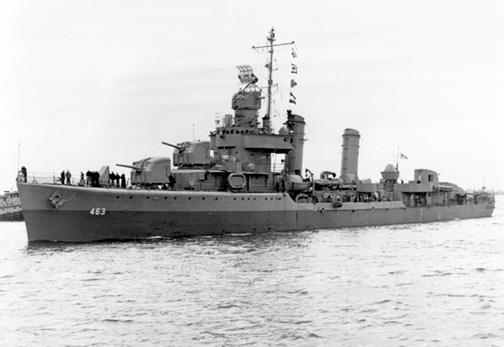
The USS Corry (DD-463)
Sunk on June 6 by fire from the Crisbecq battery, the Corry was the largest Allied warship lost in the invasion.
Photo from: USS CORRY (DD-463) - ABOUT THE SHIP
On June 7, 1st Battalion 22nd Infantry began
its first attack against the Crisbec battery, seizing the village
of Saint-Marcouf. Moving out of the village,
the Battalion was stopped by fire from the 75mm guns of Crisbecq.
A German counterattack and supporting fire from the 105mm guns of
the battery
at Azeville forced 1st Battalion to pull back. It was during this
engagement that Captain Tom Shields was killed. Shields had
assumed command of the
Battalion, then was grievously wounded. Ordering the Battalion to
withdraw from the battlefield, he called in artillery fire upon
his own position
to cover the withdrawl. He was posthumously awarded the
Distinguished Service Cross.
For his defense of the battery on June 7,
Ohmsen was awarded the Iron Cross 2nd Class in the morning and an
additional award
of the Iron Cross 1st Class in the afternoon.
On the morning of June 8 the 1st Battalion 22nd
Infantry commenced its second attack on Crisbecq. The Battalion
retook the village of Saint-Marcouf,
and penetrated the perimeter of the battery. By this time the
heavy guns of the battery had been silenced by continued US Naval
gunfire.
As 1st Battalion overran the battery Ohmsen directed the German
battery of four 105mm guns at Azeville to fire upon his position.
The deadly fire of the Azeville guns inflicted heavy casualties
on 1st Battalion, and again they withdrew. Though wounded in the
arm, Ohmsen then led
a counterattack with infantry, pushing the 1st Battalion back
through Saint-Marcouf, all the way back to the village of
Dodainville.
For his actions on June 8, Ohmsen was awarded the Knights Cross of the Iron Cross, a decoration roughly equivalent to the US Medal of Honor.
By June 11, all of the guns of the Crisbecq
battery were out of action.Running out of ammunition and
supplies, Ohmsen was ordered to retreat
to the fortress at Cherbourg. He was taken prisoner at Cherbourg
by the Americans on June 26.
On June 12, the 2nd Battalion 39th Infantry
advanced for what would have been the third ground attack on
Crisbecq by US forces.
They found the battery abandoned, thus ending the fight for the
Crisbecq battery.
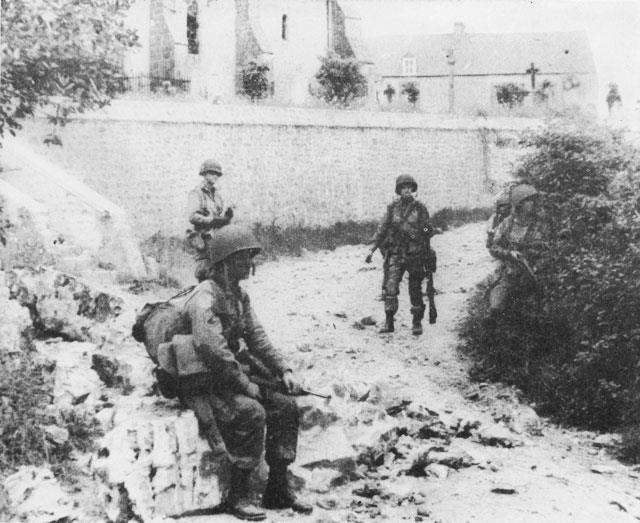
CLEARING ST. MARCOUF for the second
time, men of the 22d Infantry are shown moving cautiously through
the village on 8 June,
when the drive on Crisbecq was resumed. St. Marcouf had been
captured by the 1st Battalion the day before but had been
reoccupied
by the enemy after the failure of the first attack against
Crisbecq.
Note: The caption to the above photo
comes from the book Utah Beach to Cherbourg
published by
the Army Center of Military History and describes the soldiers in
the photo as being from the 22nd Infantry.
However they look more like paratroopers and may not be 22nd
Infantry.
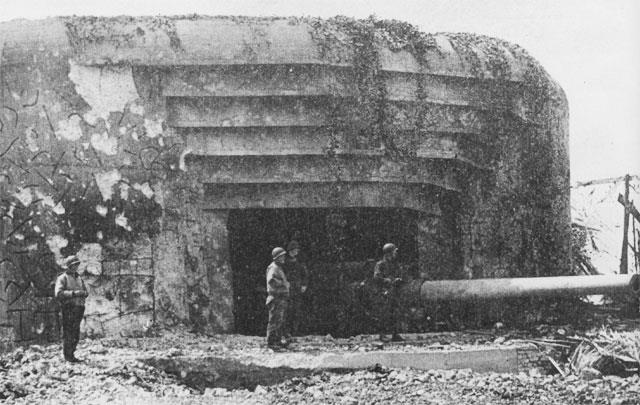
One of the 210mm guns in a casemate at
Crisbecq, seen after capture by US forces.
( A slightly different view than the photo at the top of this
page. )
Photo from The Hyper War Foundation
**********************
Home | Photos | Battles & History | Current |
Rosters & Reports | Medal of Honor | Killed
in Action |
Personnel Locator | Commanders | Station
List | Campaigns |
Honors | Insignia & Memorabilia | 4-42
Artillery | Taps |
What's New | Editorial | Links |